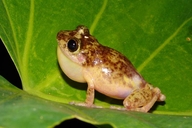|
Eleutherodactylus leberi Schwartz, 1965
Oriente Yellow-bellied Frog, Leber's Robber Frog Subgenus: Eleutherodactylus | family: Eleutherodactylidae subfamily: Eleutherodactylinae genus: Eleutherodactylus |
 © 2009 Ariel Rodriguez (1 of 1)
|
|
|
|||||||||||||||||||
|
Description This frog is yellow-green with a dark brown stippled pattern. There is a conspicuous dark and broad interocular bar and two large, dark, diffuse figures in the scapular and sacral regions. The snout is stippled and set off from the dark interocular bar by a pale area. Concealed surfaces of the thighs are dark gray, and the anterior surfaces are greenish yellow with some varied darker markings. The venter is pale yellow with some dark stippling on chin and throat. The vocal sac is vivid yellow (Schwartz 1965; Schwartz and Henderson 1985; Schwartz and Henderson 1991). Distribution and Habitat Country distribution from AmphibiaWeb's database: Cuba
Life History, Abundance, Activity, and Special Behaviors Trends and Threats Possible reasons for amphibian decline General habitat alteration and loss Comments Etymology- Named for David C. Leber, who accompanied the author in collecting specimens (Schwartz 1965). The chromosome number is 24 (Bogart 1981).
References
Bogart, J. P. (1981). ''Chromosome studies in Sminthillus from Cuba and Eleutherodactylus from Cuba and Puerto Rico (Anura: Leptodactylidae).'' Life Science Contribution, Royal Ontario Museum, 129, 1-22. Drewes, R. C., and Wilkinson, J. A. (2004). ''The California Academy of Sciences Gulf of Guinea Expedition (2001) I. The taxonomic status of the genus Nesionixalus Perret, 1976 (Anura: Hyperoliidae): treefrogs of São Tomé and Príncipe, with comments on the genus Hyperolius.'' Proceedings of the California Academy of Sciences, 55, 395-407. Garrido, O. H., and Jaume, M. L. (1984). ''Catálogo descriptivo de los anfibios y reptiles de Cuba.'' Doñana, Acta Vertebrata, 11(2), 5-128. Hedges, S. B. and Díaz, L. M. (2004). Eleutherodactylus leberi. In: IUCN 2007. 2007 IUCN Red List of Threatened Species. Hedges, S.B., Estrada, A.R., and Thomas, R. (1992). ''Three new species of Eleutherodactylus from eastern Cuba, with notes on vocalizations of other species (Anura: Leptodactylidae).'' Herpetological Monographs, 6, 68-83. Heinicke, M. P., Duellman, W. E., Hedges, S. B. (2007). ''Major Caribbean and Central American frog faunas originated by ancient oceanic dispersal.'' Proceedings of the National Academy of Sciences of the United States of America, 104(24), 10092-10097. Schwartz, A. (1965). ''A new Cuban Eleutherodactylus of the auriculatus group.'' Herpetologica, 21(1), 27-31. Schwartz, A., and Henderson, R. W. (1985). A Guide to the Identification of the Amphibians and Reptiles of the West Indies Exclusive of Hispaniola. Milwaukee Public Museum, Inland Press, Milwaukee. Schwartz, A., and Henderson, R. W. (1991). Amphibians and Reptiles of the West Indies. Descriptions, Distributions, and Natural History. University of Florida Press, Gainesville, Florida, USA. Vales, M., Álvarez, A., Montes, L., and Ávila, A. (1998). Estudio Nacional sobre la Diversidad Biológica en la República de Cuba. CESYTA, Madrid. Originally submitted by: Ansel Fong G. (first posted 2007-11-07) Edited by: Kellie Whittaker (2007-11-12) Species Account Citation: AmphibiaWeb 2007 Eleutherodactylus leberi: Oriente Yellow-bellied Frog <https://amphibiaweb.org/species/3012> University of California, Berkeley, CA, USA. Accessed Jan 13, 2025.
Feedback or comments about this page.
Citation: AmphibiaWeb. 2025. <https://amphibiaweb.org> University of California, Berkeley, CA, USA. Accessed 13 Jan 2025. AmphibiaWeb's policy on data use. |




 Map of Life
Map of Life